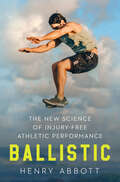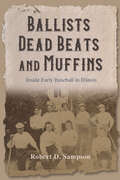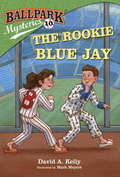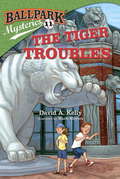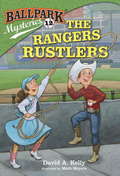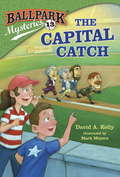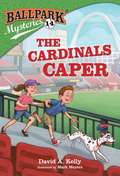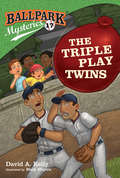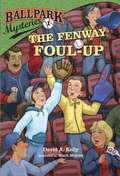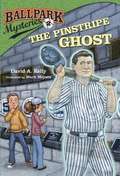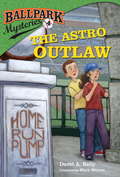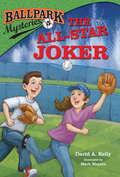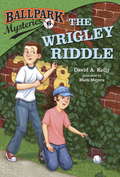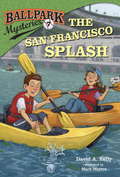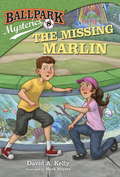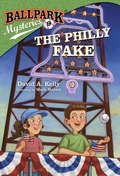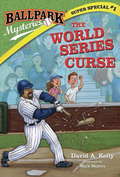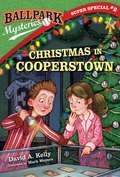- Table View
- List View
Balletball
by Erin DionneNini loves everything about ballet--the sparkles, the costumes, the twirling! But in the spring there's only baseball practice. Baseball is nothing like ballet. Or is it?Nini hates baseball. She hates that baseball is not ballet. She especially hates that Mom signed her up to play, but now she's stuck with the sport. Nini just can't bring herself to try. Her team starts to lose, but not even her teammates' disappointment will change her feelings. A pep talk from her coach and sparkly shoelaces help--a little. When Nini makes a game-winning catch using her ballet moves, she realizes that change might not be so bad after all, and ballet and baseball have more in common than she thought.
Ballistic: The New Science of Injury-Free Athletic Performance
by Henry AbbottA Next Big Idea Club Must-Read Injuries are not destiny. This revolutionary new account of the science of injury prevention shows how “ballistic” movement can help you get strong, stay healthy, and be elite. The biggest victories of medical science—over polio, smallpox, heart attacks, and the like—are stories of prevention. Then there’s sports, where we just run around until something breaks, leading to pain, frustration, and sometimes even expensive surgery. Injuries are a major cause of society’s growing mobility crisis. What if we could predict and prevent them? Blending cutting-edge science with gripping storytelling, award-winning data journalist and competitive amateur athlete Henry Abbott reveals that we are on the cusp of a new era in sports medicine, built around the science of ballistic movements—leaping and landing—and the unique fingerprint of your body’s physics. Abbott’s inspiring narrative tells the story of sports scientist Dr. Marcus Elliott and the Peak Performance Project (P3), who use technology to study how athletes move and why they get hurt. Applying machine learning and lessons from biomechanics, medicine, and physiology, doctors at P3 can now detect elevated risk of an ACL tear or a pulled hamstring like an echocardiogram can see warning signs of a heart attack. Their data-driven findings are full of surprises. Your body’s most important defense against knee and ankle injuries are the little-known muscles in the lower leg and hip area, which typical workouts rarely target. Similarly, the glutes—not the core—do the most to prevent back pain. Transformative benefits flow from training underappreciated kinds of athleticism like rotation, deceleration, and relaxation. Most of all, science shows that the best athletes don’t avoid ballistics—they master them. Through riveting stories of elite athletes overcoming injuries and pushing themselves to the limit, Abbott presents an evidence-based case for intervening early to protect our bodies. And he suggests that we can all harness the science of ballistic movement not just to run fast or jump high but to move with joy and lead fulfilling athletic lives.
Ballists, Dead Beats, and Muffins: Inside Early Baseball in Illinois
by Robert D. SampsonBaseball’s spread across Illinois paralleled the sport’s explosive growth in other parts of the country. Robert D. Sampson taps a wealth of archival research to transport readers to an era when an epidemic of “base ball on the brain” raged from Alton to Woodstock. Focusing on the years 1865 to 1869, Sampson offers a vivid portrait of a game where local teams and civic ambition went hand in hand and teams of paid professionals displaced gentlemen’s clubs devoted to sporting fair play. This preoccupation with competition sparked rules disputes and controversies over imported players while the game itself mirrored society by excluding Black Americans and women. The new era nonetheless brought out paying crowds to watch the Rock Island Lively Turtles, Fairfield Snails, and other teams take the field up and down the state. A first-ever history of early baseball in Illinois, Ballists, Dead Beats, and Muffins adds the Prairie State game’s unique shadings and colorful stories to the history of the national pastime.
Balloons and Airships: A Tale of Lighter Than Air Aviation
by Anthony Burton&“Looks at the brave (and sometimes foolish) men and women who were responsible for . . . the development of manned flight&” (History of War). This book tells the often dramatic and always fascinating story of flight in lighter than air machines. For centuries man had dreamed of flying, but all attempts failed, until in 1782 the Montgolfier brothers constructed the world&’s first hot air balloon. The following year saw the first ascent with aeronauts—not human beings but a sheep, a duck and a cockerel. But it was not long before men and women too took to the air and became ever more adventurous. In the 19th century, balloons found a new role in the military. But their use was always limited by the fact that they were at the mercy of the wind. There were numerous attempts at steering balloons, and various attempts were made to power them but it was the arrival of the internal combustion engine that saw the balloon transformed into the airship. The most famous developer of airships was Graf von Zeppelin, and the book tells the story of the use of his airships in both peacetime and at war. There were epic adventures including flights over the poles and for a time, commercial airships flourished—then came the disaster of the Hindenburg. Airships still fly today and ballooning has become a hugely popular pastime. &“Entertaining and informative . . . a series of interesting snapshots, giving a flavor of these challenging and daring exploits.&” —Flying in Ireland &“Absolutely enthralling.&” —Books Monthly
Ballpark Mysteries #10: The Rookie Blue Jay
by David A. Kelly Mark MeyersBatter up! Ballpark Mysteries combine baseball action with exciting whodunits for early chapter book readers! Mike and Kate can't wait to watch their rookie hero Dusty Martin in action. But something is throwing the Blue Jays' star off his game. Then, when no one else is looking, Mike sees mysterious ghost lights flying across the field. Is the ballpark haunted? And could Dusty have seen the lights, too? Ballpark Mysteries are the all-star matchup of fun sleuthing and baseball action, perfect for readers of Ron Roy's A to Z Mysteries and Matt Christopher's sports books, and younger siblings of Mike Lupica fans. Each Ballpark Mystery also features "Dugout Notes," with more amazing baseball facts.
Ballpark Mysteries #11: The Tiger Troubles
by David A. Kelly Mark MeyersBatter up! Ballpark Mysteries® combine baseball action with exciting whodunits for early-chapter book readers! Someone is blackmailing the Detroit Tigers' famous slugger, Tony! They've stolen his favorite trophy, and unless he fills a tiger-shaped bag with signed baseballs, he'll never see the trophy again. Luckily, all-star sleuths Mike and Kate are ready to pounce on the case. Can they track down the thief in time to save Tony's treasure? Ballpark Mysteries are the all-star matchup of fun sleuthing and baseball action, perfect for readers of Ron Roy's A to Z Mysteries and Matt Christopher's sports books, and younger siblings of Mike Lupica fans. Each Ballpark Mystery also features "Dugout Notes," with more amazing baseball facts.
Ballpark Mysteries #12: The Rangers Rustlers
by David A. Kelly Mark MeyersBatter up! Ballpark Mysteries® combine baseball action with exciting whodunits for early chapter book readers! Let's play ball, y'all! Mike and Kate are very excited to watch a Texas Rangers game. Mike even bought an official shirt. But little did he know--it's a fake! A sneaky crook is tricking Rangers fans into buying the wrong shirts. Can the cousins help a real-life police ranger round up the culprit? Ballpark Mysteries are the all-star matchup of fun sleuthing and baseball action, perfect for readers of Ron Roy's A to Z Mysteries and Matt Christopher's sports books, and younger siblings of Mike Lupica fans. Each Ballpark Mystery also features Dugout Notes, with more amazing baseball facts.
Ballpark Mysteries #13: The Capital Catch
by Mark Meyers David KellyBatter up! Baseball action and exciting whodunits star in this series! Next up is Washington D.C. and the Nationals team! <p><p> Mike and Kate are about to face their biggest, most important mystery yet! Why? It involves the president of the United States! The president’s brother is a catcher on the Nationals baseball team, and someone is stealing his equipment! Can these super-sleuths help the commander in chief catch a criminal? <p> Ballpark Mysteries are the all-star matchup of fun sleuthing and baseball action, perfect for readers of Ron Roy’s A to Z Mysteries and Matt Christopher’s sports books, and younger siblings of Mike Lupica fans. Each Ballpark Mystery also features Dugout Notes, with more amazing baseball facts.
Ballpark Mysteries #14: The Cardinals Caper
by David A. Kelly Mark MeyersBatter up! Baseball action and exciting whodunits star in this chapter book series! Next up is St. Louis Cardinals!It's a special day in St. Louis, and there's a pregame celebration with Clydesdale horses that drive around the edge of the stadium before the game. Mike and Kate get to meet the horses and the Dalmatian that rides along. Then, during the game, they find out the Dalmatian is missing. They rush to investigate and find a ransom note. The criminal will return the dog if they can get one of St. Louis's World Series trophies! Can Mike and Kate catch the crook and rescue the pup?Ballpark Mysteries are the all-star matchup of fun sleuthing and baseball action, perfect for readers of Ron Roy's A to Z Mysteries and Matt Christopher's sports books, and younger siblings of Mike Lupica fans. Each Ballpark Mystery also features Dugout Notes with more amazing baseball facts.
Ballpark Mysteries #15: The Baltimore Bandit (Ballpark Mysteries #15)
by David A. Kelly Mark MeyersBatter up! Baseball action and exciting whodunits star in this chapter book series! Next up is Baltimore!Mike and Kate's next mystery is legendary! The great pitching legend Babe Ruth's first team was in Baltimore, so the Orioles' ballpark has one of his gloves on display. While Mike and Kate are eating pancakes with the Orioles' pitcher, the glove goes missing. The only clue they have is a gold coin . . . which points back to the pancake-eating pitcher! But how could he have done it? It will take more snacks at the ballpark, a talking parrot, and expert detective work to solve this mystery! Ballpark Mysteries are the all-star matchup of fun sleuthing and baseball action, perfect for readers of Ron Roy's A to Z Mysteries and Matt Christopher's sports books, and younger siblings of Mike Lupica fans. Each Ballpark Mystery also features Dugout Notes with more amazing baseball facts.
Ballpark Mysteries #16: The Colorado Curveball (Ballpark Mysteries #16)
by David A. KellyBatter up! Baseball action and exciting whodunits star in this chapter book series! Next up is Colorado! Mike and Kate arrive in Colorado to a ballpark covered in snow! Luckily, the stadium has a heater that can melt the fluffy flakes in time for next day's game. But when the ballpark engineers get a mysterious note saying that someone may tamper with the scoreboard, the snow becomes the least of the cousins' problems. It's time for Mike and Kate to switch into sleuth mode and solve a mystery that will take them underground, a mile above sea level, and even face to face with a dinosaur!Ballpark Mysteries are the all-star matchup of fun sleuthing and baseball action, perfect for readers of Ron Roy's A to Z Mysteries and Matt Christopher's sports books, and younger siblings of Mike Lupica fans. Each Ballpark Mystery also features Dugout Notes with more amazing baseball facts.
Ballpark Mysteries #17: The Triple Play Twins (Ballpark Mysteries #17)
by David A. KellyBatter up! Baseball action and exciting whodunits star in this chapter book series! Next up is Minnesota! Mike and Kate travel to Minneapolis to meet the Minnesota Twins' star players: Marco and Pedro, a dynamic twin duo known for their signature triple plays. But after a water balloon attack on the players and a suspect on the run, questions start to pile up. Is someone trying to mess with Marco and Pedro's chances of making the playoffs? As Mike and Kate investigate, they meet Polly and Molly, twin Minnesota locals who lend a helping hand--or two. With new friends by their side, can Mike and Kate solve this mystery?Ballpark Mysteries are the all-star matchup of fun sleuthing and baseball action, perfect for readers of Ron Roy's A to Z Mysteries and Matt Christopher's sports books, and younger siblings of Mike Lupica fans. Each Ballpark Mystery also features Dugout Notes with more amazing baseball facts.
Ballpark Mysteries #18: The Atlanta Alibi (Ballpark Mysteries #18)
by David A. KellyBatter up! Baseball action and exciting whodunits star in this chapter book series! Next up is Atlanta! The A-team takes A-Town! Mike and Kate are in Atlanta, where Hammerin' Hank hit his legendary 715th home run. But Hank's historic bat and ball, which he used to break Babe Ruth's record, have been stolen! Good thing Mike and Kate are sleuthing pros. Can the cousins track down Hank Aaron's missing treasure . . . before it's gone forever?Ballpark Mysteries are the all-star matchup of fun sleuthing and baseball action, perfect for readers of Ron Roy's A to Z Mysteries and Matt Christopher's sports books, and younger siblings of Mike Lupica fans. Each Ballpark Mystery also features Dugout Notes with more amazing baseball facts.
Ballpark Mysteries #1: The Fenway Foul-up
by David A. KellyNow leading off the line-up-book #1 in a brand-new early chapter book mystery series where each book is set in a different American ballpark! Thanks to Kate's mom, a sports reporter, cousins Mike Walsh and Kate Hopkins have tickets to the Red Sox game and All Access passes to Fenway Park. But as they're watching batting practice before the game, the lucky bat of Red Sox star slugger Big D is stolen . . . right in front of dozens of people. Without the bat, Big D can't seem to hit a thing. Can Kate and Mike figure out who pinched the bat before Big D and the Sox chalk up a loss? The Fenway Foul-Up includes a fun fact page about Boston's Fenway Park. Cross Ron Roy's mystery series with Matt Christopher's sports books and you get the Ballpark Mysteries: fun, puzzling whodunnits aimed right at beginning readers. From the Trade Paperback edition.
Ballpark Mysteries #2: The Pinstripe Ghost
by David A. KellyCousins Kate and Mike visit Kate's father, a baseball scout for the Dodgers, in Los Angeles just as a series of suspicious events lead him to think that someone is trying to steal his scouting reports.
Ballpark Mysteries #2: The Pinstripe Ghost
by David A. Kelly Mark MeyersBatting second—and perfect for Halloween—book #2 in an early chapter book mystery series where each book is set in a different American ballpark! Mike and Kate are waiting for Kate's mom at a boring press conference in Yankee Stadium when the team official says something that makes Mike perk up his ears. There are rumors that the ghost of Babe Ruth is haunting the new stadium! A chill air blasts down a service hallway before every home game, along with various thumps and bumps. Is the Bambino really searching for his missing locker?The Pinstripe Ghost includes a fun fact page about New York's Yankee Stadium.Cross Ron Roy's mystery series with Matt Christopher's sports books and you get the Ballpark Mysteries: fun, puzzling whodunnits aimed right at beginning readers.From the Trade Paperback edition.
Ballpark Mysteries #3: The L.A. Dodger
by David A. Kelly Mark MeyersNow batting third--book #3 in a brand-new early chapter book mystery series where each book is set in a different American ballpark! It's spring break and Kate and Mike are off to Los Angeles to visit Kate's dad, a scout for the Dodgers. But all is not sunny in L.A.--strange things have been happening to Kate's dad. Pages have gone missing from his clipboard. He's gotten threatening phone calls. And he thinks he's being followed! Is someone after Mr. Hopkins's top secret scouting reports?The L.A. Dodger includes a fun fact page about Los Angeles's Dodger Stadium.Cross Ron Roy's A to Z mystery series with Matt Christopher's sports books and you get the Ballpark Mysteries: fun, puzzling whodunnits aimed at the younger brothers and sisters of John Feinstein's fans.From the Trade Paperback edition.
Ballpark Mysteries #4: The Astro Outlaw
by David A. Kelly Mark MeyersNow batting clean-up--book #4 in a new early chapter book mystery series where each book is set in a different American ballpark! Houston, we have a problem! Before a game at the Astros' ballpark, Mike and Kate get to meet astronaut commander Nick Rice at the nearby Houston Space Center. He's planning to display a very rare moonrock at an autographing event later. But just before the event, a nefarious outlaw knocks out the commander and steals the moonrock! Can Mike and Kate figure out who did it . . . when their only clue is a broken green feather?The Astro Outlaw includes a fun act page about the Houston Astros' stadium with trivia about the train on the outfield wall and the homerun gas pump.Cross Ron Roy's A to Z Mystery series with Matt Christopher's sports books and you get the Ballpark Mysteries: fun, puzzling whodunnits aimed at the younger brothers and sisters of John Feinstein's fans.From the Trade Paperback edition.
Ballpark Mysteries #5: The All-Star Joker
by David A. Kelly Mark MeyersNext up to the plate--book #5 in our early chapter book mystery series, where each book is set in a different American ballpark! The stars are out in Kansas City . . . the baseball stars, that is! Mike and Kate are at the All-Star game, and even get to go on the field during the Home Run Derby to catch pop-ups! That's where they meet Andy, whose dad, Josh Robinson, is an All-Star catcher. But before the Home Derby ends, Josh finds himself in hot water. Someone is playing practical jokes on the other players, and the coach is sure it's him. Andy swears his dad is innocent. Who would want to frame Josh? And why?The All-Star Joker includes a fun fact page about Kansas City's stadium.Cross Ron Roy's A to Z mystery series with Matt Christopher's sports books and you get the Ballpark Mysteries: fun, puzzling whodunnits aimed at the younger brothers and sisters of John Feinstein's fans.
Ballpark Mysteries #6: The Wrigley Riddle
by David A. Kelly Mark MeyersNext up to the plate--book #6 in our early chapter book mystery series, where each book is set in a different American ballpark! Ivy-covered walls--they're the most famous part of the Chicago Cubs' historic ballpark, Wrigley Field. Mike and Kate can't wait to get down on the field to see the ivy for themselves. But when they do, they're horrified to discover patches of the ivy have been ripped away! Who would want to sabotage the stadium? Is it someone trying to curse the Cubs? Or is the rumor of a treasure hidden under the ivy tempting greedy fans? The Wrigley Riddle includes a fun fact page about Chicago's Wrigley Field.Cross Ron Roy's A to Z Mystery series with Matt Christopher's sports books and you get the Ballpark Mysteries: fun, puzzling whodunits aimed at the younger brothers and sisters of John Feinstein's fans.
Ballpark Mysteries #7: The San Francisco Splash
by David A. Kelly Mark MeyersTime for a seventh-inning stretch! The San Francisco Splash is book #7 in our early chapter book mystery series, where each book is set in a different American ballpark! Splash! A hit soars over the walls of the San Francisco ballpark on the bay and drops into the water. But then Mike and Kate hear another, much larger splash nearby . . . and this time it's not a baseball. It's a man overboard! And when he's pulled from the water, the old-time ballplayer discovers his World Series ring is gone! Is it at the bottom of the bay? Or was it somehow stolen by a long-ago rival? The San Francisco Splash includes several pages of "Dugout Notes," fun facts about San Francisco's recently built ballpark.Cross Ron Roy's A to Z Mystery series with Matt Christopher's sports books and you get the Ballpark Mysteries: fun, puzzling whodunits aimed at the younger brothers and sisters of John Feinstein's fans.
Ballpark Mysteries #8: The Missing Marlin
by David A. Kelly Mark MeyersIt's the eighth inning! The Missing Marlin is book #8 in our early chapter book mystery series, where each book is set in a different American ballpark!Mike and Kate are in Miami visiting Kate's Uncle Oliver--and the Miami Marlins ballpark, of course! Uncle Oliver is in charge of keeping the new fish tanks at the ballpark fully stocked, but strange things keep happening. Kate swears she saw an endangered sea turtle in one of the tanks. Then some of Uncle Oliver's rare fish go missing, including his favorite, Marlin. Something fishy is going on in Miami!The Missing Marlin includes several pages of "Dugout Notes," fun facts about Miami's recently built ballpark with its homerun statue, fish tanks, and swimming pool.Cross Ron Roy's A to Z Mystery series with Matt Christopher's sports books and you get the Ballpark Mysteries: fun, puzzling whodunits aimed at the younger brothers and sisters of John Feinstein fans.
Ballpark Mysteries #9: The Philly Fake
by David A. Kelly Mark MeyersIt's the ninth inning! The Philly Fake is book #9 in our early chapter book mystery series, where each book is set in a different American ballpark!What better city to spend the Fourth of July than Philadelphia? For Mike and Kate, the holiday is all about hot dogs, history, and baseball! But the Phillies are in no mood to celebrate. They keep losing, and some people blame the lovable Phillie Phanatic! Can Mike and Kate help the Phanatic clear his name?The Philly Fake includes several pages of "Dugout Notes," fun facts about Philly's ballpark.Cross Ron Roy's A to Z Mystery series with Matt Christopher's sports books and you get the Ballpark Mysteries: fun, puzzling whodunits aimed at the younger brothers and sisters of John Feinstein fans.
Ballpark Mysteries Super Special #1: The World Series Curse
by David A. Kelly Mark MeyersIt's the BIGGEST baseball mystery yet--at the WORLD SERIES! Red Sox versus Cubs. Game five. It looks like Mike and Kate are about to watch the Cubs win it all. But then someone starts messing with the team--ruining equipment, getting Cubs players in trouble, and even stirring up an old baseball curse. Now the Red Sox are coming back! Who will win the ultimate baseball trophy? And can Mike and Kate make sure it's won fair and square? Ballpark Mysteries are the all-star matchup of fun sleuthing and baseball action, perfect for readers of Ron Roy's A to Z Mysteries and Matt Christopher's sports books, and younger siblings of Mike Lupica fans. Each Ballpark Mystery also features Dugout Notes, with amazing baseball facts.
Ballpark Mysteries Super Special #2: Christmas in Cooperstown
by David A. Kelly Mark MeyersMike and Kate get the BEST Christmas present ever—a mystery at the Baseball Hall of Fame! After volunteering to wrap presents for charity, Mike and Kate get a special thank-you: a sleepover at the Baseball Hall of Fame! But when they’re sneaking around the museum late at night, their flashlight reveals that one of the famous baseball cards on display is a fake! Can they find the real card, catch the crook, and get the presents to the charity’s Christmas party on time? It’s up to Mike and Kate to turn this Christmas mess into a Christmas miracle! Ballpark Mysteries are the all-star matchup of fun sleuthing and baseball action, perfect for readers of Ron Roy’s A to Z Mysteries and Matt Christopher’s sports books, and younger siblings of Mike Lupica fans. Each Ballpark Mystery also features Dugout Notes, with amazing baseball facts.

